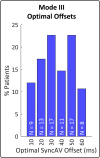Programming Cardiac Resynchronization Therapy for Electrical Synchrony: Reaching Beyond Left Bundle Branch Block and Left Ventricular Activation Delay
- PMID: 29432133
- PMCID: PMC5850248
- DOI: 10.1161/JAHA.117.007489
Programming Cardiac Resynchronization Therapy for Electrical Synchrony: Reaching Beyond Left Bundle Branch Block and Left Ventricular Activation Delay
Abstract
Background: QRS narrowing following cardiac resynchronization therapy with biventricular (BiV) or left ventricular (LV) pacing is likely affected by patient-specific conduction characteristics (PR, qLV, LV-paced propagation interval), making a universal programming strategy likely ineffective. We tested these factors using a novel, device-based algorithm (SyncAV) that automatically adjusts paced atrioventricular delay (default or programmable offset) according to intrinsic atrioventricular conduction.
Methods and results: Seventy-five patients undergoing cardiac resynchronization therapy (age 66±11 years; 65% male; 32% with ischemic cardiomyopathy; LV ejection fraction 28±8%; QRS duration 162±16 ms) with intact atrioventricular conduction (PR interval 194±34, range 128-300 ms), left bundle branch block, and optimized LV lead position were studied at implant. QRS duration (QRSd) reduction was compared for the following pacing configurations: nominal simultaneous BiV (Mode I: paced/sensed atrioventricular delay=140/110 ms), BiV+SyncAV with 50 ms offset (Mode II), BiV+SyncAV with offset that minimized QRSd (Mode III), or LV-only pacing+SyncAV with 50 ms offset (Mode IV). The intrinsic QRSd (162±16 ms) was reduced to 142±17 ms (-11.8%) by Mode I, 136±14 ms (-15.6%) by Mode IV, and 132±13 ms (-17.8%) by Mode II. Mode III yielded the shortest overall QRSd (123±12 ms, -23.9% [P<0.001 versus all modes]) and was the only configuration without QRSd prolongation in any patient. QRS narrowing occurred regardless of QRSd, PR, or LV-paced intervals, or underlying ischemic disease.
Conclusions: Post-implant electrical optimization in already well-selected patients with left bundle branch block and optimized LV lead position is facilitated by patient-tailored BiV pacing adjusted to intrinsic atrioventricular timing using an automatic device-based algorithm.
Keywords: cardiac resynchronization therapy; left bundle branch block; optimization.
© 2018 The Authors. Published on behalf of the American Heart Association, Inc., by Wiley.
Figures






References
-
- Cleland JG, Abraham WT, Linde C, Gold MR, Young JB, Claude Daubert J, Sherfesee L, Wells GA, Tang AS. An individual patient meta‐analysis of five randomized trials assessing the effects of cardiac resynchronization therapy on morbidity and mortality in patients with symptomatic heart failure. Eur Heart J. 2013;34:3547–3556. - PMC - PubMed
-
- Tolosana JM, Mont L. Cardiac resynchronization therapy: how to decrease nonresponders. Heart Fail Clin. 2017;13:233–240. - PubMed
-
- Rickard J, Cheng A, Spragg D, Bansal S, Niebauer MJ, Baranowski B, Cantillon D, Tchou P, Grimm RA, Tang W, Wilkoff B, Varma N. Durability of survival effect of cardiac resynchronization therapy by level of left ventricular functional improvement: fate of “non‐responders”. Heart Rhythm. 2014;11:412–416. - PubMed
-
- Brignole M, Auricchio A, Baron‐Esquivias G, Bordachar P, Boriani G, Breithardt OA, Cleland J, Deharo JC, Delgado V, Elliott PM, Gorenek B, Israel CW, Leclercq C, Linde C, Mont L, Padeletti L, Sutton R, Vardas PE, Zamorano JL, Achenbach S, Baumgartner H, Bax JJ, Bueno H, Dean V, Deaton C, Erol C, Fagard R, Ferrari R, Hasdai D, Hoes AW, Kirchhof P, Knuuti J, Kolh P, Lancellotti P, Linhart A, Nihoyannopoulos P, Piepoli MF, Ponikowski P, Sirnes PA, Tamargo JL, Tendera M, Torbicki A, Wijns W, Windecker S, Kirchhof P, Blomstrom‐Lundqvist C, Badano LP, Aliyev F, Bansch D, Baumgartner H, Bsata W, Buser P, Charron P, Daubert JC, Dobreanu D, Faerestrand S, Hasdai D, Hoes AW, Le Heuzey JY, Mavrakis H, McDonagh T, Merino JL, Nawar MM, Nielsen JC, Pieske B, Poposka L, Ruschitzka F, Tendera M, Van Gelder IC, Wilson CM. 2013 ESC guidelines on cardiac pacing and cardiac resynchronization therapy: the Task Force on cardiac pacing and resynchronization therapy of the European Society of Cardiology (ESC). Developed in collaboration with the European Heart Rhythm Association (EHRA). Europace. 2013;15:1070–1118. - PubMed
Publication types
MeSH terms
LinkOut - more resources
Full Text Sources
Other Literature Sources
Medical
Research Materials

